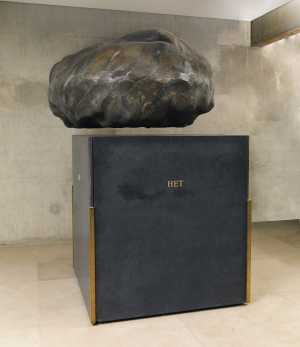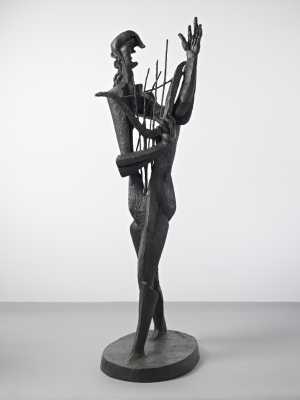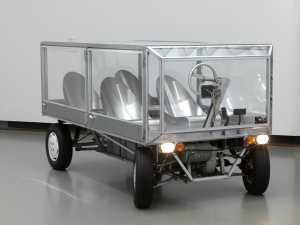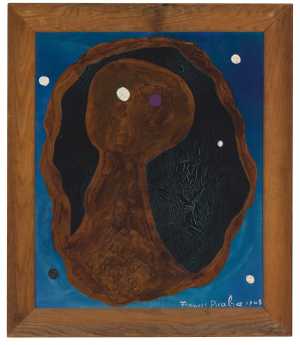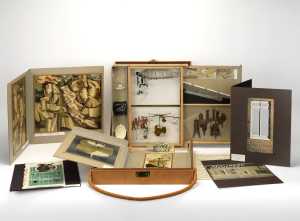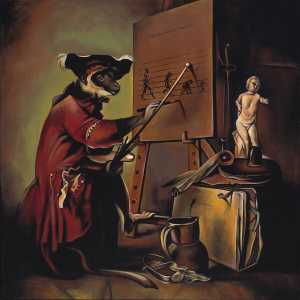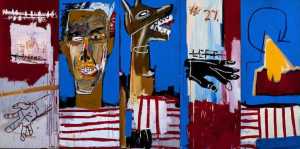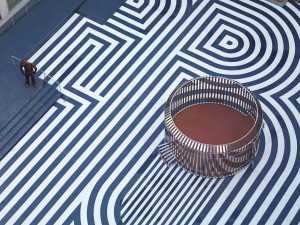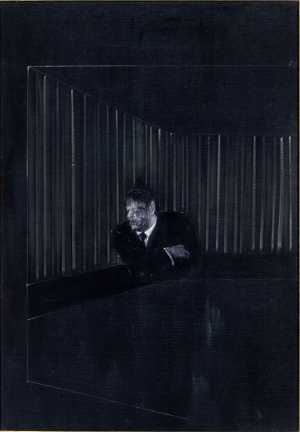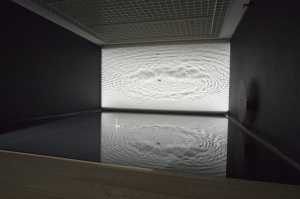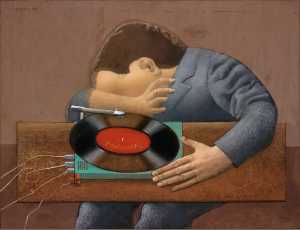Francis Picabia was born into a wealthy family. Despite his comfortable beginnings, he was an artistic anarchist. He made paintings in every conceivable style, thus doing his best to undermine traditional artistic conventions. This crudely painted portrait is an ironic critique of art and a celebration of absolute intellectual freedom.

Specifications
| Title | Viens avec moi là-bas |
|---|---|
| Material and technique | Oil on cardboard |
| Object type |
Painting
> Painting
> Two-dimensional object
> Art object
|
| Location | This object is in storage |
| Dimensions |
Height 64,5 cm Width 54,5 cm |
|---|---|
| Artists |
Artist:
Francis Picabia
|
| Accession number | 3402 (MK) |
| Credits | Purchase Stichting Fonds Willem van Rede. On permanent loan from the Cultural Heritage Agency of the Netherlands, 1997 |
| Department | Modern Art |
| Acquisition date | 1997 |
| Creation date | in 1948 |
| Collector | Collector / W. van Rede |
| Provenance | Galerie Neuendorf, Frankfurt am Main; Geertjan Visser, Retie 1989-97 |
| Exhibitions | Otterlo 1992; Hamburg/Rotterdam 1997-98; Rotterdam 1996a; Rotterdam 2010; Rotterdam 2017b |
| Internal exhibitions |
Collectie - surrealisme (2017) |
| External exhibitions |
A Surreal Shock – Masterpieces from Museum Boijmans Van Beuningen (2021) Surrealist Art - Masterpieces from Museum Boijmans Van Beuningen (2021) Only the Marvelous is Beautiful (2022) Dal nulla al sogno (2018) Dalí, Magritte, Man Ray and Surrealism. Highlights from Museum Boijmans Van Beuningen (2023) A Surreal Shock. Masterpieces from Museum Boijmans Van Beuningen (2023) |
| Research |
Show research A dream collection - Surrealism in Museum Boijmans Van Beuningen |
| Literature | Camfield 1979, pp. 262, 294, fig. 399; Borràs 1985, cat. no. 900, fig. 1124; Hamburg/Rotterdam 1997-98, p. 128 |
| Material | |
| Object | |
| Geographical origin | France > Western Europe > Europe |
Do you have corrections or additional information about this work? Please, send us a message
Entry catalogue A dream collection - Surrealism in Museum Boijmans Van Beuningen
Author: Marijke Peyser
The title of the crudely painted work Viens avec moi là-bas could suggest that it is an invitation from the artist to ‘go’ somewhere with him. However the way Francis Picabia’s late abstract works should be interpreted is not always clear. During an interview in 1945, for instance, Picabia was asked a question that could have applied to this work: ‘But what are we seeing in your current canvases?’[1] The artist replied: ‘Each person sees something different and even something else from day to day according to his mood. But the form he sees is not attached to a single real object having a life of its own, and so does not betray that “something” that is the message from my being to his and is visible, I am sure, to the delight of many who contemplate these canvases. It is equal to the inner satisfaction that I feel at a particular moment while working that tells me the canvas is finished.’
In 1945, having spent the war years in the South of France, Picabia and his wife Olga Mohier moved back to Paris. Soon young artists working in the abstract style, Francis Bott, Raoul Ubac, Roberto Matta, Hans Hartung, Pierre Soulages and Georges Mathieu among them, began to gather around the elderly master. They set the tone in the post-war Paris art world and were regarded as practitioners of l’art informel – the European counterpart of American Abstract Expressionism. Their canvases were fuelled by intuition and spontaneity. For them the physical gesture – the way the paint was applied – was of great importance.
The post-war years were distressing for Picabia. Money worries, deteriorating health and a lack of recognition of his recent works dogged the artist.[2] For the first time in his life, Picabia the bon-viveur, who once owned seven yachts and a hundred and twenty-seven cars and had more women than he could count, did not have enough money for the simplest of things.[3] His first wife, Gabrielle Buffet, called upon her contacts to sell Picabia’s work, but her attempts met with little success.[4] The first major post-war exhibition of contemporary art was the Salon des Surindépendants in 1945, where Picabia had five canvases. The reaction of the Parisian critics, however, was mostly negative.[5] Francis Picabia – Peintures sur-irréalistes, his first post-war monographic exhibition in France at the Denise René gallery in Paris in 1946, and his participation in the First Great International Exhibition of Surrealism in Galerie Maeght in the summer of 1947 were poorly received.[6] Despite the mixed reviews, Picabia went through one last development in the late 1940s. He made a number of radical abstract ‘point’ paintings, among them Viens avec moi là-bas, which were shown for the first time at Galerie des Deux Îles in 1949 and once again he was criticized as well as appreciated.
All about the artist
Francis Picabia
Parijs 1879 - Parijs 1953
Early in his career, Francis Picabia experimented with a variety of styles, including Impressionism and Cubism. In 1911, he met Marcel Duchamp, who had an...
Bekijk het volledige profiel

